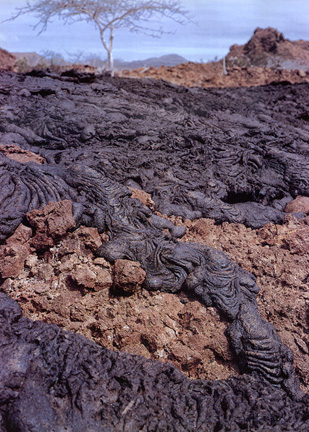|
Volcanism in the Galapagos Islands Aa and Pahoehoe Lava  | | Two types of basaltic lava, 'pahoehoe' and 'aa'. The chunky brown lava is 'aa' while the ropy black lava is 'pahoehoe'.Picture source: http://www.geo.cornell.edu/geology/GalapagosWWW/LavaTypes.html |
Arial volcanoes around the world are separated into four categories that depend on the type of material erupted. The most explosive (Volcanian) type emits primarily gases. The less explosive (Domean) type ejects viscous, or sticky, magma and acid. The loud (Hawaiian) type ejects magma that is fluid and basic, such as basaltic lava. This is the case of the Galapagos Islands. The mixed (Strobolian) type ejects a combination of gases, liquids and solid materials.
The Galapagos Islands is a host to both basalt and, less commonly, rhyolitic rocks. Basalt is a fine-grained, dark brown to black rock that lava solidifies into. It is made of minerals, such as, calcium-rich plagioclase, pyroxene, and lesser amounts of olivine. Basalt is the main type of rock in oceanic environments, such as mid-ocean ridges and hot spots.
Lava is molten material that emits from a volcano during an eruption. Flow speed depends on the viscosity of a flow. Viscosity is a fluid's resistance to flow. If the lava has high viscosity, it will act as a ductile, slow moving mass. Lavas with high viscosity tend to be more explosive because gases can not easily escape from the rising magma. If the lava has low viscosity then the molten material will act fluidly and flow fast down the volcano flanks.
As lava travels down the volcano sides, the surface of the flow will cool much more rapidly. The surface of the flow forms two different types called 'aa' and 'pahoehoe'. Aa lava (pronounced ah-ah) has a rough, jagged surface due to the gas explosions tearing apart the external crust. It looks like a pile of blocks and rock fragments but underneath lies molten lava. As the lava flow advances it is churned and folded over itself, allowing gas to escape. The other kind of basaltic flow is pahoehoe (pronounced pa-hoy-hoy). Pahoehoe and aa have the same chemical composition although pahoehoe is less viscous (more fluid) then aa because the gases have yet to escape. Pahoehoe lava flow's have smooth, ropy surfaces. Underneath the surface skin is hot molten lava, pushing forward, wrinkling the skin further and producing a more ropelike appearance. Commonly you will see aa at the front of the lava flow while pahoehoe is within the flow.
|







